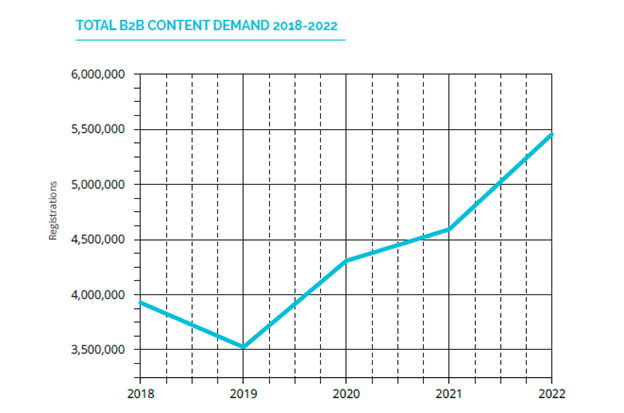Intent data is an essential part of sales enablement.
Naturally, marketing has a key role to play, too.
But with the volume of content online continuing to increase, how exactly should B2B marketers highlight the right content for sales teams to use at the right time?
5 Steps B2B Marketers Should Take to Sync Up with the Buying Cycle
In this post, we’ll look at the steps B2B marketers should take to align their sales content and assets with buyer activities and where they are in the buying cycle.

A B2B sales astronaut celebrates as they’ve closed a deal, all thanks to the intent-led content provided by marketing. Created using DALLE via ChatGPT.
Identify the key themes and information needs of in-market buyers at each sales stage
A good place to start is by pinpointing the key themes and information in-market buyers need at each stage of their journey by analyzing intent data to uncover common trends, pain points, and interests.
This data can come from your own first-party data in your CRM. It can also be acquired through tools such as Intentive or Audience Explorer that show you what buyers are looking for when researching online.

Image caption: NetLine has a helpful guide on getting the most out of Audience Explorer. Download your copy!
After that, make sure you ask your sales team. They can tell you, first-hand, what questions buyers are asking and what concerns they are experiencing at each stage of the journey.
They can also supply any first-party interaction data that may be captured—from notes or emails in CRM, live chat records, or sales intelligence tools (e.g., Gong.io) that analyze interactions with buyers.
To better understand buyer needs, marketers can also look at other sources on current needs and challenges of your target market, such as insights from industry trend reports and analyst firms. You can gain insight by examining your competitors’ content as well.
From there, you’ll want to map all of these out on a buyer journey map to identify key decision-making moments and the types of information your buyers are looking for. If necessary, it may be helpful to break these down further by key vertical, segment, or buyer role.

Image caption: Many B2B buyer journey templates, such as this one from UXPressia, are available online which can help you.
Categorize your existing content in line with these themes and needs
Next, it’s time to take a look at your existing content to tag and categorize it based on the identified themes and buyer needs you mapped out earlier. While this process can be done manually, it certainly doesn’t have to be.
There are digital asset and content management tools on the market that can help.
Audit your existing content library against buyer-intent themes and needs to identify gaps. Having those key themes and information needs already mapped out by buyer stage comes in handy. It allows you to quickly identify where you lack content that your buyers need.
A content matrix can help visualize your content strategy. By creating one, you can map content to specific opportunity sales stages, intent themes, and needs.

Image caption: The volume of content being consumed by buyers shows no sign of slowing down. Source: NetLine’s 2023 State of B2B Content Consumption and Demand Report.
Create and curate content to fill in the gaps
Now that the gaps in your content have been identified, you’ll need to fill those gaps by either creating content or curating it.
When creating new content, it makes sense to be efficient and start filling in the gaps that will deliver the greatest value first. To find out what is likely to be the most important content, take advantage of your engagement data, and don’t be afraid of going back to your sales team and getting their thoughts.
Creating new content can be time-consuming and use up marketing resources that could be better used elsewhere. So, consider curating some of the content you need to fill the gaps.
Some ideas and sources include:
- Industry publications and B2B media sites: Follow reputable industry magazines, newspapers, and websites. They’re excellent sources of news, trends, and insights that you can share with your audience. Most will also offer sponsored content options too that can help close any gaps.
- Educational institutions: Look for research papers, case studies, and articles from universities or research institutions. These sources often provide in-depth, cutting-edge information that can elevate your content.
- Trade associations and organizations: Keep an eye on content from trade associations and industry organizations. They often publish valuable resources, including reports, whitepapers, and newsletters—especially in areas such as regulatory change and compliance.
- Market research and analyst firms: Share findings and analysis from market research firms like Gartner, Forrester, and IDC.
Their reports and insights can help your audience make informed decisions and stay ahead of the curve. Like B2B media firms, they also offer commercial options such as licensing agreements (such as the Forrester Wave or Gartner Magic Quadrant reports) or undertake research studies.
- Award-winning brands and their practices: Curate content from recognized award winners in your industry and showcase any best practices they demonstrate. This adds credibility to your brand and ensures you’re sharing top-notch content.
- Influencers and thought leaders: Follow industry influencers and thought leaders on social media and subscribe to their blogs. Share their content, opinions, and insights to engage your audience and spark conversations.
For a fee, many will also speak at your events or collaborate with your brand, providing it doesn’t affect either any existing relationships or any editorial position they may have.
- Videos and webinars: Share informative and engaging videos or webinars from industry experts. These visual formats can help explain complex concepts and provide a more interactive learning experience.
- Podcasts: Curate episodes from popular industry podcasts that discuss relevant topics or interview thought leaders. Podcasts offer a convenient way for your audience to consume content while multitasking.
- eBooks and whitepapers: Share in-depth resources like eBooks and whitepapers that dive deep into specific topics. This long-form content (much of which can be found on TradePub) can help your audience better understand complex concepts and industry trends.
- Infographics and visual content: Visual content can be a powerful way to convey complex information quickly. Share infographics, charts, or data visualizations that provide valuable insights in an easily digestible format.
- Tools and templates: Curate useful tools, templates, or checklists that help your audience simplify their work processes or solve specific problems.
- Industry events and conferences: Share key takeaways, presentations, or panel discussions from industry events and conferences. This keeps your audience in the loop and provides them with valuable insights from experts.
In fact, curating content for use and sharing by your sales team can be a particularly powerful tool in the context of social selling, which can help sales reps engage with potential customers and showcase their expertise.

Two astronaut sales reps engaged in social selling inside a spaceship. Created using DALLE via ChatGPT.
Offer a variety of formats and provide the ability for sales to personalize and distribute this content
It’s important not to limit your content to one or two formats. Buyers seeking to learn more about a solution have varying preferences on the kind of content they want to consume. Some might want to watch a short, succinct video, while others are happy to consume a detailed whitepaper.
Preferences change over time. For instance, findings from NetLine’s 2023 Content Consumption Demand Report show that in 2021, eBook registrations accounted for a little more than two-fifths (43%) of all content consumption, but in 2022, that share dropped to about one-third (33.6%).
There are tools and platforms available that enable sales teams to easily personalize content for their prospects. Starting at the most basic level, these can include email templates stored in a shared folder or documents with stats and insights to quote in conversations.
PowerPoint decks can also be useful, as they can be customized as needed, with a salesperson picking and choosing which slides to share. At an advanced level, sales enablement software, some of which your team might already be using, can help to personalize content as needed.
No matter what content you are using, make sure that there are easy ways through which they can share it on different channels.
Make it available through email, on social, or even on dynamic web pages specific to a buyer and/or the account. After all, just as content format preferences vary, so do the channels where buyers do their research.
Get this content into your sales team’s workflow
Having content that addresses buyers’ needs at every level of their journey is only worthwhile if your sales team takes full advantage of it. There are several ways to get the content into your sales team workflow; here are a few to consider:
- Take a simple approach and tell them where the content is: Circulate and communicate where the content is and how sales can use it. This could be as simple as having folders by theme on SharePoint/Dropbox/Google Drive, or a spreadsheet with hyperlinks to relevant content.
- Inject content recommendations into the sales tech stack: Use data relating to buyer interests and opportunity stage to dynamically recommend content within your CRM or the tool most frequently used by sales (e.g., Drift, Outreach). This is a key reason why categorizing content (as discussed earlier) can be so powerful.
- Offer training and host meetings: Offer training sessions to your sales teams or hold special meetings such as “Lunch and Learn” sessions to bring them up to speed. During these sessions, you can supply resources directly to your sales teams, show how they can use and personalize them, and answer any questions they might have.
- Increase usage by asking for suggestions: Proactively seek feedback from sales reps to hear their recommendations, discover any issues, and make any content as effective for them as possible.
- Track usage: If and where possible, track content usage and performance metrics to continuously refine the content you share with sales. In fact, this functionality may even be present within the tools that your company already has.
Got content but need to distribute it? Look no further!
If you need to quickly connect in-market buyers to your sales team, NetLine can help. Personalize content and confidently connect with in-market buyers.
